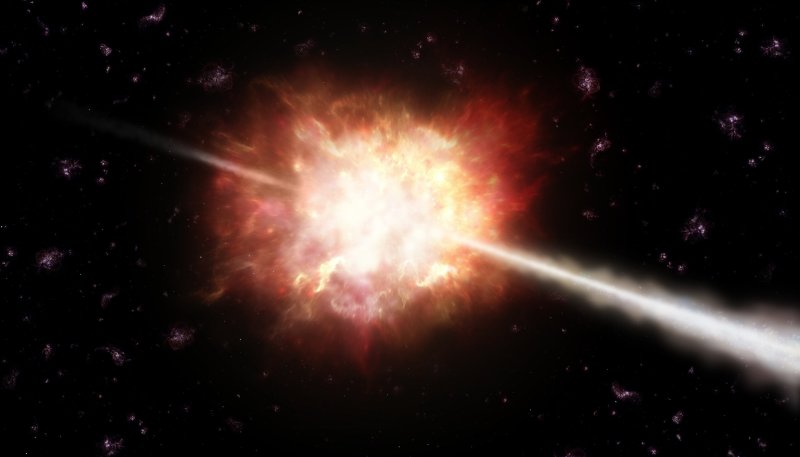Astronomers turned telescopes from around the world to study the blast, dubbed GRB 090423. National Science Foundation's Very Large Array (VLA) first looked for the object the day after the discovery, detected the first radio waves from the blast a week later, then recorded changes in the object until it faded from view more than two months later.
The scientists concluded that the explosion was more energetic than most GRBs, was a nearly-spherical blast, and that it expanded into a tenuous and relatively uniform gaseous medium surrounding the star.

Artistic impression of a gamma ray burst like GRB 090423. They release a tremendous amount of energy in this short time making them the most powerful events in the Universe. They are thought to be mostly associated with the explosion of stars that collapse into black holes. In the explosion, two jets of very fast-moving material are ejected, as depicted in this artist’s illustration. If a jet happens to be aimed at Earth, we see a brief but powerful gamma-ray burst. Credit: ESO/A. Roquette
Astronomers suspect that the very first stars in the Universe were very different -- brighter, hotter, and more massive -- from those that formed later. They hope to find evidence for these giants by observing objects as distant as GRB 090423 or more distant.
"This explosion provides an unprecedented look at an era when the Universe was very young and also was undergoing drastic changes. The primal cosmic darkness was being pierced by the light of the first stars and the first galaxies were beginning to form. The star that exploded in this event was a member of one of these earliest generations of stars," said Dale Frail of the National Radio Astronomy Observatory.
"The best way to distinguish these distant, early-generation stars is by studying their explosive deaths, as supernovae or Gamma Ray Bursts," said Poonam Chandra, of the Royal Military College of Canada, and leader of the research team. While the data on GRB 090423 don't indicate that it resulted from the death of such a monster star, new astronomical tools are coming that may reveal them.
"The Atacama Large Millimeter/submillimeter Array (ALMA), will allow us to pick out these very-distant GRBs more easily so we can target them for intense followup observations. The Expanded Very Large Array, with much greater sensitivity than the current VLA, will let us follow these blasts much longer and learn much more about their energies and environments. We'll be able to look back even further in time," Frail said. Both ALMA and the EVLA are scheduled for completion in 2012.




Comments